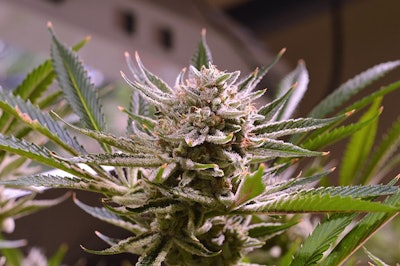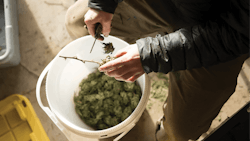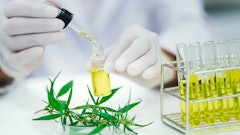

The company’s financial adviser, Serge Chistov (pictured left), says that the technology will tee up cannabis products that are cleaner, more efficient, more discrete and—in a word—more bioavailable for the many needs of the medical cannabis market.
The Colorado cannabis company has based its business on a philosophy of preserving and nurturing cannabis in a natural environment, and is now looking to formulate the plant’s active ingredients into products that will be welcomed by the human body, Chistov says. Ultimately, the company plans to use this technology to create capsules, transdermal products and orally dissolvable strips.
Cannabis is a hydrophobic substance, meaning that compounds like THC and CBD do not mix, dissolve or blend into water. This makes the delivery of medical cannabis difficult, as the human body is made up mostly of water.
“We’re made more with water than with fats and lipids,” Chistov says. “So, to be effective, medicine—especially one that needs to enter through the membranes like skin … —needs to have … physical characteristics which will trick the body or help the body understand it as a ‘liking-water’ substance. So, you need to tweak oil into something that is a little bit more palatable for the body to process.”
Commonly used techniques in the cannabis industry include the emulsion of fat and water, or the use of emulsifiers that turn the fat into a milkier substance, allowing small particles of fat to be suspended in water.
“The problem is, there are particles in the milk—those fat particles—[and] they’re pretty sizable,” Chistov says. “They’re minuscule to the naked eye, but they’re still pretty sizable to penetrate the skin barrier on your body. … So, the drive for us and the goal for us was to see how small we can create the size of the particles of these special nano-emulsions, so they can become more active.”

The company’s nano-sized products also increase bioavailability, Chistov says. “We want the consumer or the patient to use less medicine for the desired effect.”
When medication is delivered directly into the bloodstream, the patient receives all its active ingredients, he says. For example, if a doctor orders a patient to receive 100 ccs of a drug intravenously, the patient will receive all 100 ccs. If the doctor orders the patient to receive 100 mg of medication in pill form, however, some of the 100 mg will disappear as the medication works its way through the patient’s digestive system. “The 100 percent will be IV, direct into the bloodstream,” Chistov says. “Everything else is in percentages of that 100 percent. So, if something is 50 bioavailable, it means that out of the 100 mg of active ingredients, 50 will get lost, 50 will get in.”
When a patient smokes cannabis that is 25 percent THC by volume, he or she intends to receive 250 mg of THC, but about 90 percent of that THC is burned off and turns to smoke, leaving only about 20-40 mg of THC that is actually consumed.
“So, that brought us … to our technology, which allows us … to have less active ingredient that’s packaged and made as such, so it’s more eager to get into your body because it’s made so tiny and small to become more bioavailable,” Chistov says. “Now you can have the same desired effect with less active ingredients, so in the future, the cost of that medication will be way smaller for you, and you can have it active and available for you as fast as smoking because even through the pretty tough membrane, like skin, some of our formulation travels within the first 45-90 seconds.”
Although formal testing is still being done on the technology to assess its exact bioavailability, Honest Marijuana Company has conducted in-house testing, and is confident that the official results will show that consumers will register effects of products that use the nano-technology much quicker than products in other forms, such as edibles.
“Eating that much active ingredient in an edible, you will not feel,” Chistov says. “Me personally, I was never able to register 3-5 mg of THC, [but] I was able to register it … [with this technology] as it’s traveling right through my skin into my bloodstream. I do believe that this bioavailability is quite a substantial margin number [compared to] any other form of consumption that I’m aware of.”

For transdermal products, Honest Marijuana Company has hired a company to design a base to keep the nano-formulation directly on the skin’s surface, allowing it to absorb directly into the body.
The company has also been working on an orally dissolvable strip, Chistov says, which is placed on the tongue and dissolves within 30 seconds to deliver an individual dosage into the bloodstream. The compliant packaging for this product is currently being finalized, Chistov says, which includes the logo and the symbol for THC printed on each individual strip.
“The regulations on the packaging are changing so rapidly, so it took us a little bit longer to come up with a proper packaging solution for this formulation,” he says.
The other components of this particular product—including pharmaceutical excipients and an emulsifier—meet food- and pharmaceutical-grade standards, Chistov adds.
Products using this nano-technology may help patients and consumers use cannabis more discretely, Chistov says. “It is not as socially acceptable as some other ways of relaxation, just like alcohol or tobacco,” he says. “The technology would allow the creation of very inconspicuous, effective, fast-acting medicine that can be taken by the responsible adult in any shape or form anywhere, without getting their hands dirty and sticky, smelling like cannabis fire and smoke, and without almost any calories as opposed to some of the chocolates and edibles and gummies right now.”
And fast-acting creams and transdermal products will also help children who use medicinal cannabis, he adds. “A child who has a rough time swallowing the oil or taking a tincture or swallowing a pill can get an active medication delivered through the surface of his skin, which will still give him a central impact, not just topical and local, but rather bring the medication into his bloodstream and help with the entire body.”
“The speed of the delivery, the inconspicuous medication and the bioavailability will eventually answer these questions for the consumer as to, ‘Do I really need to roll the whole gram joint, or is just seven or eight mg of active ingredient good enough for me?’” Chistov says. “When the market is stable [and] the hype is gone, and cannabis just becomes another commercially available crop, all of the costs will be translated into the monthly … or weekly consumption, so it makes it more efficient for the consumer to benefit from this beautiful plant.”
Photos courtesy of Honest Marijuana Company

























